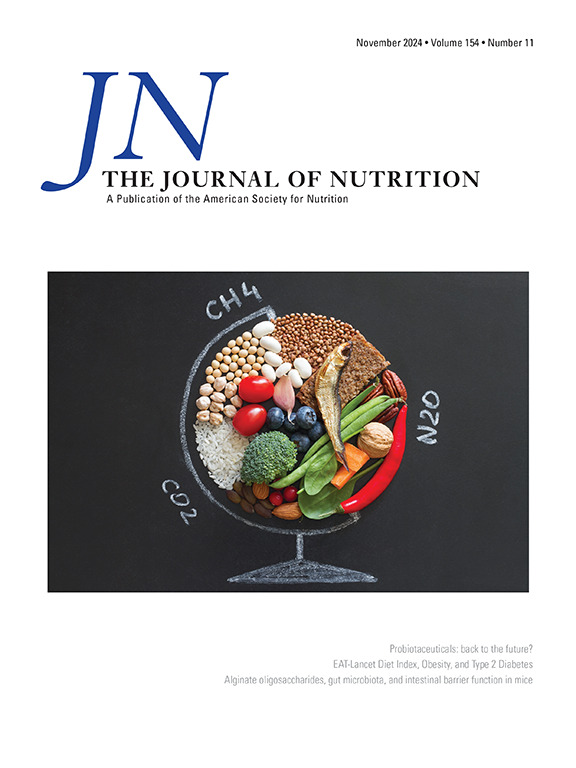Associations between Dietary Carbohydrate Intakes, Fatty Acid Oxidation Rates, and Sites of Ectopic Fat Deposition Over Two Years in Persons with Treated HIV
IF 3.8
3区 医学
Q2 NUTRITION & DIETETICS
引用次数: 0
Abstract
Background
Persons with human immunodeficiency virus (HIV) on long-term antiretroviral therapy (ART) have exaggerated accumulation of ectopic fat and cardiometabolic disease risk.
Objectives
The objective of this study was to characterize longitudinal changes in habitual diet and macronutrient oxidation in relation to changes in abdominal adipose tissue and ectopic fat sites using magnetic resonance and computed tomography imaging.
Methods
A prospective cohort of 49 males with HIV had comprehensive assessments at baseline, 52 wk (year 1), and 104 wk (year 2). Linear mixed effects models accounted for the correlation structure in the data and estimated effects over time. Fixed effects included baseline value of the outcome, age, body mass index [BMI (in kg/m2)], time since HIV diagnosis, and duration of ART.
Results
The consumption of simple carbohydrates decreased over time (total and added sugars, P = 0.03) concomitant with increased ratio of fatty acid to carbohydrate oxidation (P = 0.01). The amount of abdominal subcutaneous adipose tissue decreased 15% (P < 0.0001), and the amount of visceral adipose tissue (VAT) decreased 7% (P = 0.009) simultaneously with improved subcutaneous adipose tissue and VAT densities. Improvement in VAT density is associated with reduced fat fraction of the liver (r = –0.28, P = 0.04) and thighs (r = –0.41, P = 0.03), indicating overall reduced ectopic fat accumulation. However, pancreas density decreased (P = 0.03), and no statistically significant change was observed in skeletal muscle density (P = 0.16), suggesting tissue-specific impacts.
Conclusions
These findings support the relationship between dietary carbohydrate intake, fat oxidation rate, and fat mobilization to reduce ectopic lipid deposition in persons with HIV. Although modest changes in dietary intakes show potential for improving metabolic flexibility and body composition among individuals on long-term ART, some organs and tissues may not respond in tandem with other depots of ectopic fat.
两年内接受治疗的HIV患者饮食碳水化合物摄入量、脂肪酸氧化率和异位脂肪沉积部位之间的关系
背景:接受长期抗逆转录病毒治疗(ART)的HIV感染者(PWH)异位脂肪积累和心脏代谢疾病风险过高。目的:利用磁共振和CT成像技术,探讨习惯饮食和常量营养素氧化的纵向变化与腹部脂肪组织和异位脂肪部位的变化之间的关系。方法:在基线、52周(第1年)和104周(第2年)对49名男性HIV感染者进行全面评估。线性混合效应模型解释了数据中的相关结构和随时间的估计效应。固定效应包括结果基线值、年龄、BMI、自HIV诊断以来的时间和抗逆转录病毒治疗的持续时间。结果:随着时间的推移,简单碳水化合物的消耗(总糖和添加糖,p = 0.03)随着脂肪酸与碳水化合物氧化比的增加而减少(p = 0.01)。腹部皮下脂肪组织(SAT)减少15% (p < 0.0001),内脏脂肪组织(VAT)减少7% (p = 0.009)。VAT密度的改善与肝脏(r = -0.28, p = 0.04)和大腿(r = -0.41, p = 0.03)脂肪含量的降低相关,表明异位脂肪积累总体减少。然而,胰腺密度下降(p = 0.03),骨骼肌密度无统计学意义变化(p = 0.16),提示组织特异性影响。结论:这些发现支持膳食碳水化合物摄入量、脂肪氧化率和脂肪动员之间的关系,以减少PWH的异位脂质沉积。虽然饮食摄入量的适度变化显示出长期抗逆转录病毒治疗的个体改善代谢灵活性和身体组成的潜力,但一些器官和组织可能不会与其他异位脂肪库一起反应。
本文章由计算机程序翻译,如有差异,请以英文原文为准。
求助全文
约1分钟内获得全文
求助全文
来源期刊

Journal of Nutrition
医学-营养学
CiteScore
7.60
自引率
4.80%
发文量
260
审稿时长
39 days
期刊介绍:
The Journal of Nutrition (JN/J Nutr) publishes peer-reviewed original research papers covering all aspects of experimental nutrition in humans and other animal species; special articles such as reviews and biographies of prominent nutrition scientists; and issues, opinions, and commentaries on controversial issues in nutrition. Supplements are frequently published to provide extended discussion of topics of special interest.
 求助内容:
求助内容: 应助结果提醒方式:
应助结果提醒方式:


